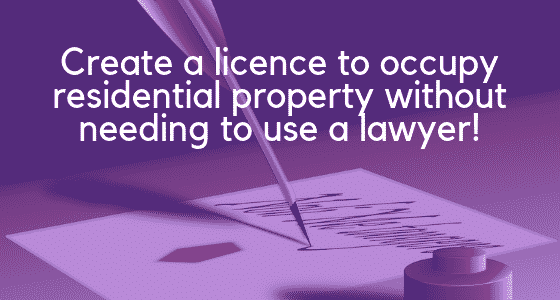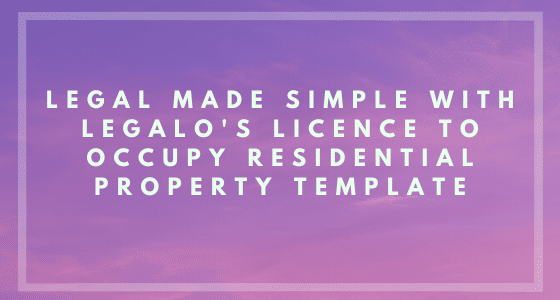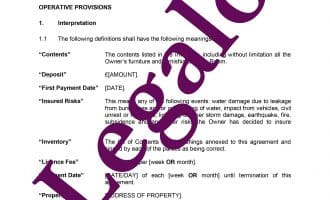Licence To Occupy Residential Property
Our Residential Licence to Occupy template:
- Now over 500 sold!
- Is UK-lawyer-drafted for reliability
- Comes will full guidance notes for easy drafting
- Puts in place a reliable contract with your tenant

How Does It Work?
-
1. Download
-
2. Edit
-
3. Print
-
4. Sign
This is our licence to occupy residential property. It is suitable for residential property (but not commercial property). Once you have downloaded it, you can easily edit it to your requirements. We include full guidance notes with the Word download, so completing it is simple and quick.
This is one of our best-selling templates, with over 500 sold!
You can rely on our online document service to provide you with a robust and reliable agreement at a very cost-effective price. David, our co-founding solicitor, drafted this template.
When to use this Licence To Occupy Residential Property template
Use this licence agreement:
- when you are going to let part of a residential property on a short-term basis;
- for homes in multiple occupation (‘HMOs’) where occupation is not expected to be in the medium to long-term; or
- where people do not regard this as their home, e.g. hostels, hotels, boarding houses or student accommodation (including a student HMO).
However, if:
1. you are going to give the tenant exclusive use of just one room in a property that is also your home, then you should use our lodger agreement template instead; or
2. you are letting the whole of the flat or building to one or more tenants, which they will regard as their home (i.e. the landlord doesn’t live there and it is not an HMO), use our assured shorthold tenancy template.

Using the right template
Please do not use a template for the wrong situation. If you do, you are likely to find difficulties with eviction processes later or misunderstand what rights the tenants have. We provide detailed guides for each template that we sell. The guide states:
- when you should use the template (or not use it);
- what rights it gives the tenants; and
- what eviction processes apply.
If in doubt as to which one to use, then you should consider using the assured shorthold tenancy template as a default. This would ensure you don’t breach the rights of a tenant. You can find more details on when and when not to use this template in the guide that accompanies it.
If you are still in doubt, you can use an online test to see if you are likely using the right template at Shelter’s website here (NB it is written as if the person taking the test is the tenant, but if you ignore that it works perfectly well): http://england.shelter.org.uk/get_advice/downloads_and_tools/tenancy_checker.
If the premises are commercial property to be let to a business for business occupation, rather than residential use, then try our commercial licence to occupy instead. Otherwise, this residential licence is the correct agreement for you to use. See our guide for further details on this.
If you are having someone else guarantee the occupier’s obligations, then please try our Licence to Occupy Residential Property with Guarantor template.

FAQs on Licences
Below we have addressed some of the most popular questions about licences from the Internet.
What is a residential licence to occupy?
This is a right to occupy part of a building. It is generally on a non-exclusive basis, and generally for relatively short period of time. You should only use one in a limited set of circumstances, and one in which it is a genuine situation. Most cases are tenancies. So you should use an Assured Shorthold Tenancy agreement then, instead of a licence to occupy residential property.
Is a licence to occupy the same as a tenancy agreement?
No. Under a tenancy, the tenant has better rights, such as greater protection against eviction and deposit protection. A licence to occupy residential property is a less strong right. It should, however, only be used in appropriate situations.
Why use a licence instead of a tenancy?
You should use a licence only in appropriate circumstances. Many landlords overuse them, because it is slightly easier to evict a licensee than a tenant and the occupier has fewer rights in a genuine licence situation. However, you should only use them in genuine circumstances, or you could be prosecuted, or use the wrong eviction notice and process and get your case thrown out by the court to have to start over, possibly with having to pay the tenant’s court costs and compensation.
If you are renting out a whole house to a family and they clearly intend to stay there a long time (or could potentially do so), then you should be granting them a Tenancy Agreement, not a licence to occupy. A licence to occupy is more suited to short-term lettings, such as holiday lets, temporary local authority accommodation for homeless applicants, student flats, rooms in houses in multiple occupancy (HMOs), lodger situations, hotels and hostels, service accommodation for employees required to live there for their job (e.g. caretakers), and the rental of boats (e.g. houseboats).
Can a licence become a tenancy?
If you misuse the licence to occupy by using it in circumstances that are inappropriate, then the court might well rule that it is a tenancy. Just because you labelled the agreement a “licence to occupy”, does not make that title legally binding. If occupancy under a licence runs on a lot longer than expected, it can also turn into a tenancy.
How does a licence to occupy work?
The landlord grants the licence in writing, the occupant signs it, and both keep copies. The licence gives the occupant a right to occupy certain parts of a building in accordance with the terms of the licence and in return for the payment of a licence fee. The licence might impose certain restrictions, such as on the amount of people who can live there, or on what the occupant can do there.
Does a licence give you an estate or an interest in land?
No. It gives you a temporary right to be there but not on an exclusive basis, so it is not classed as an interest in land.
How long can a licence to occupy last?
A licence to occupy, of its nature, should be a short-term, informal matter. They are usually for up to 6 or 12 months. If you are looking at a longer situation developing, then consider using a tenancy agreement instead.
Can a tenant grant a licence to occupy residential property?
Generally a tenancy agreement will ban the tenant subletting the whole or part, or letting part under a licence to occupy. If it does not, then in theory a tenant can grant a licence to occupy. If a tenant grants a licence to occupy in breach of his tenancy, then the landlord could evict him.
How do you terminate a licence to occupy?
You give notice in accordance with the terms of the licence. This is usually for not less than 28 days’ notice (in accordance with section 5 of the Protection from Eviction Act 1977), unless there has been a breach of the licence by the occupier. You do not need to use a Section 21 notice (they are only for tenancies) if it is a genuine licence situation.
How do I evict someone with a licence to occupy residential property?
First, you give notice to terminate the licence in accordance with the terms of the licence. If the occupier does not move out at the end of the notice period, then you need a court order for eviction, but the notice period is a bit shorter than needed for a tenancy. The exception to this is if the person is a lodger in your home. Then you do not need an eviction order.
Can a licence to occupy be verbal?
Technically, yes, but this is highly inadvisable. Any verbal agreements are hard to enforce if a dispute arises. A written agreement is good evidence as to what the parties agreed and when. It is much “better to be safe than sorry” when it comes to legal agreements being in writing.
Does a licence to occupy residential property need to be in writing?
It is important, in order to avoid legal disputes, that any legal document is in writing. For the licence to occupy, this includes setting out in writing the licence fee and the notice period to terminate it.
Is a licence to occupy legally binding?
A written licence to occupy is legally binding, but as it is easier to terminate than a tenancy, it is not as strong a right as a tenancy. However, a “sham” licence is at risk of:
- being treated by the court as a tenancy;
- you can get prosecuted by Trading Standards for this; and
- you might have to pay compensation to the tenant too.
So do not misuse them, for the reasons notes above.
Does a licence to occupy need to be signed as a deed?
No. It is a simple contract. You can sign it without needing witnesses, i.e. not as a deed.
Who pays for a licence to occupy residential property?
The occupier pays the licence fee under a licence to occupy. There is no Stamp Duty to pay the grant of a licence to occupy (that applies to leases of commercial property of 7 years or longer).



